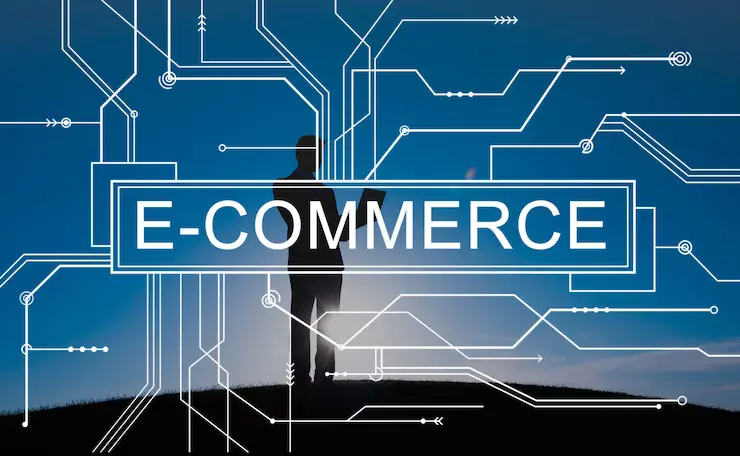A carefully structured ecommerce tech stack is your key to unlocking the untapped potential of your online store and gaining fast-paced growth. But many online businesses are not aware of what exactly is an e-commerce tech stack and how you can create one that can grow your company to new heights.
In this blog, we’ll help you figure out the most fundamental concepts of an e-commerce tech stack. You’ll also learn its key components, requirements, and considerations for building a solid tech stack. Whether you’re an experienced entrepreneur or a newbie to the e-commerce space, read this guide to gain more knowledge and insights about the future of technology. Let’s learn how to build an Ecommerce Tech Stack that drives growth, optimizes operations, and provides an amazing customer experience.
What Is Meant by an Ecommerce Tech Stack?
An Ecommerce Tech Stack refers to the collection of software, applications, and technologies that are strategically integrated to power and support an online business or Ecommerce store. It acts as a comprehensive toolkit that streamlines various aspects of an Ecommerce operation, ensuring smooth functionality, enhanced user experience, and efficient management of tasks.
Think of it this way: your Ecommerce Tech Stack is like having a team of experts working round the clock to make your business thrive. From choosing the perfect platform to ensuring seamless integration of various software, each component plays a vital role in your online journey.
Just like a front-end that dazzles your customers with a beautiful and user-friendly interface, and a back-end that handles all the behind-the-scenes magic, an Ecommerce Tech Stack brings harmony to your entire online business.
Components of an Ecommerce Technology Stack
Behind every successful Ecommerce store lies a well-structured Ecommerce Technology Stack. This stack is divided into 2 main components, each important in powering and supporting the entire online business’s operations:
1. Front-end
Like the front end of any website, app, or portal, an e-commerce tech stack is the appealing front of your online store through which your customer can engage directly. It includes everything that is visually present to your users on your website such as its layout, design, colors, graphics, buttons, and other visual aspects. The front end is responsible for providing your visitors with an engaging and interesting user experience.
For creating the front end of your e-commerce tech stack, web developers use a variety of programming languages such as HTML, CSS, and Javascript. Developers ensure that the website is responsive and suitable for all devices. The goal is to provide a user-friendly and visually appealing platform that invites visitors to explore products.
2. Back-end
The backend is the component that drives an Ecommerce Technology Stack like an engine. This critical component handles behind-the-scenes duties like transaction processing, inventory management, payment gateway management, and secure client data storage.
Back-end functionality is built by web developers using programming languages such as PHP, Ruby, Python, or JavaScript (Node.js). Databases such as MySQL or PostgreSQL are also used to efficiently store and retrieve data. A well-optimized backend ensures fast loading times, smooth order fulfillment, and dependable security measures to protect sensitive client information.

How to Build an E-commerce Tech Stack?
Building an E-commerce Tech Stack is crucial in establishing a successful online business. It involves carefully selecting and integrating various software, applications, and technologies that work cohesively to support and enhance your E-commerce operations. Here’s a detailed explanation of the steps involved:
- Use a Well-Managed Ecommerce Platform
- Avoid Component Isolation
- Choose a Modular Architecture

1. Use a Well-Managed Ecommerce Platform
Choosing the right platform for developing your ecommerce tech stack is very important as it acts like a foundation. There are various options in the market, including Shopify, WooCommerce, BigCommerce, or Magento, which you can use to develop your tech stack. Each of these platforms has its own unique set of features and benefits.
But while choosing a platform, you should keep things like simplicity of use, customization possibilities, scalability, security, and customer support in mind. A well-managed Ecommerce platform has a user-friendly interface, simplifies the setup process, and provides tools for efficiently managing products, inventory, payments, and customer data.
2. Avoid Component Isolation
Component isolation is the employment of diverse tools and technologies that do not interact effectively with one another, resulting in fragmented processes and inefficient workflows. To avoid this, concentrate on integrating tools that can operate together seamlessly. For example, if you utilize inventory management software, make sure it works well with your selected Ecommerce platform and other critical tools such as payment gateways and delivery providers. Integration saves manual data entry, streamlines procedures, and delivers a uniform picture of your E-commerce data, saving time and effort while reducing error risk.
3. Choose a Modular Architecture
A modular architecture enables you to create a flexible and scalable E-commerce Tech Stack. A modular architecture, as opposed to a monolithic approach with all-in-one solutions, involves selecting distinct components that serve specific objectives. This strategy gives you the ability to tailor your Tech Stack to your specific business requirements, allowing you to add or replace modules as your company expands or new technologies emerge. Using a modular strategy allows you to easily react to shifting market trends and stay ahead of the competition.
Important Factors to Consider While Creating an Ecommerce Tech Stack
Several critical variables must be carefully considered in order to construct a robust and efficient Tech Stack that corresponds with your business goals. Let’s look at the essential things that any Ecommerce entrepreneur should be aware of:
- Cost
- Complexity
- Ease
- Support
Cost: Maximizing Value Without Breaking the Bank
When developing an Ecommerce Tech Stack, cost-effectiveness is critical. While it may be tempting to choose the most current and feature-rich solutions available, it is necessary to strike a balance between utility and expense. Examine the entire cost of ownership, taking into account upfront charges, subscription payments, and prospective integration costs. Consider free or open-source solutions without sacrificing quality. Remember that putting value ahead of luxury might free your valuable resources for other elements of your Ecommerce journey.

Complexity: Embrace Simplicity for Seamless Operations
The ease of management and maintenance of your Ecommerce Tech Stack has a significant impact on the day-to-day operations of your digital storefront. Complex systems may cause your team’s learning curve to be higher, raising the risk of errors and delays. Consider using user-friendly interfaces and straightforward tools that require little training and assistance. A properly developed ecommerce tech stack allows your team to focus on key activities, streamline procedures, and provide a wonderful client experience without being weighed down by complex systems.
Ease: Integration for Enhanced Efficiency
Efficient integration is the backbone of a successful Ecommerce Tech Stack. Ensure that the selected components can seamlessly communicate with each other, promoting data flow and eliminating manual workarounds. Smooth integration between your Ecommerce platform, inventory management system, payment gateways, and shipping solutions is crucial for optimizing efficiency and avoiding component isolation. Choose technologies with robust APIs and a track record of successful integrations to foster a harmonious Tech Stack that works together effortlessly.

Support: Partnering for Ongoing Success
When embarking on your Ecommerce journey, reliable support is a lifeline. Consider the level of customer support offered by each component vendor in your Tech Stack. Opt for vendors with responsive support teams that can address any technical issues promptly. Strong support ensures minimal downtime and swift resolutions, allowing you to focus on growing your business without the stress of technology hiccups.
Which Business Functions Are Involved in an Ecommerce Tech Stack?
An Ecommerce Tech Stack involves several essential business functions, each vital in supporting and optimizing your online store. Here are detailed descriptions of these functions:
- Content Management System (CMS)
- Customer Relationship Management (CRM)
- Tools for Analytics
- Shipping and Logistics Software
1. Content Management System (CMS)
A Content Management System is a main component of an Ecommerce Tech Stack that empowers you to manage and update your website content efficiently. From product descriptions and images to blog posts and promotional banners, a robust CMS allows you to control and organize your online content. A CMS also helps you ensure that your website is updated, entertaining, gives useful information to visitors, and a smooth user experience.

2. Customer Relationship Management (CRM)
Customer Relationship Management software is essential for nurturing valuable relationships with your customers. A CRM system collects and organizes customer information, allowing you to obtain insights into their preferences, behavior, and purchasing history. You can tailor marketing efforts, give targeted promotions, and provide great customer service by harnessing this information. A well-integrated CRM in your Tech Stack strengthens customer loyalty and drives repeat business.

3. Tools for Analytics
Data analysis is the core operation used for making informed business decisions. Including tools for analytics in your Ecommerce Tech Stack is crucial for understanding key performance indicators (KPIs), sales trends, website traffic, and customer behavior. These insights allow you to optimize marketing strategies, identify growth opportunities, and improve overall Ecommerce performance. Popular analytics tools like Google Analytics or specialized Ecommerce analytics platforms offer valuable insights to guide your business strategy.
4. Shipping and Logistics Software
Efficiently managing shipping and logistics is essential for a successful ecommerce business. Shipping and logistics software helps streamline order fulfillment, track shipments, manage inventory, and coordinate with carriers. It ensures fast and proper delivery, increases customer happiness, and reduces shipping costs. Integrating this component into your Tech Stack enables smooth coordination between your online store and shipping processes, creating a seamless end-to-end customer experience.
Build an Ecommerce Tech Stack for Your Business!
The success of your Ecommerce business is strongly dependent on the careful consideration of these important parameters while establishing your Tech Stack. The right combination of cost-effectiveness, simplicity, ease of integration, and complete support will allow your online business to thrive and give exceptional experiences to your valued customers.
Shopsmith assists companies in building their ecommerce tech stack. We have seasoned specialists with top-tier skills to provide you with ecommerce tech services. Businesses in need of dependable software solutions can always count on our assistance.
How to choose the right e-commerce tech stack for your business?
Identify your individual goals, consider scalability and compatibility with future development, and investigate the best-suited platforms and technologies for seamless integration and optimal performance when selecting the correct E-commerce tech stack for your business.
What are the best platforms for hosting an e-commerce store?
Shopify, WooCommerce (WordPress), BigCommerce, and Magento are the top platforms for hosting an E-commerce store, with each having unique features and scalability to suit different business sizes and requirements.




